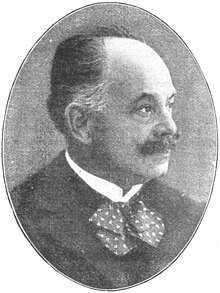Heinrich Müller-Breslau: Difference between revisions
No edit summary Tags: Mobile edit Mobile web edit Advanced mobile edit |
Added sources |
||
| Line 1: | Line 1: | ||
{{unreferenced|date=January 2014}} |
{{unreferenced|date=January 2014}} |
||
[[File:Heinrich Mueller-Breslau.jpg|thumb|Heinrich Mueller-Breslau]] |
[[File:Heinrich Mueller-Breslau.jpg|thumb|Heinrich Mueller-Breslau]] |
||
'''Heinrich Franz Bernhard Müller''' (May 13, 1851 in [[Breslau]] – April 24, 1925 in [[Grunewald (locality)|Grunewald]], Berlin, known as '''Müller-Breslau''' from around 1875 to distinguish him from other people with similar names) was a German [[civil engineer]] and [[Education in Germany#Secondary education|high school teacher]]. He provided significant contributions to the theory of beams and frames in [[structural analysis]]. |
'''Heinrich Franz Bernhard Müller''' (May 13, 1851 in [[Breslau]] – April 24, 1925 in [[Grunewald (locality)|Grunewald]], Berlin, known as '''Müller-Breslau''' from around 1875 to distinguish him from other people with similar names) was a German [[civil engineer]] and [[Education in Germany#Secondary education|high school teacher]].<ref>{{Cite web |date=2017-08-29 |title=Heinrich Müller: Die bizarre Karriere des toten Gestapo-Chefs - WELT |url=https://www.welt.de/geschichte/zweiter-weltkrieg/article121403942/Die-bizarre-Karriere-des-toten-Gestapo-Chefs.html |access-date=2023-11-12 |website=DIE WELT |language=de}}</ref><ref>{{Cite web |title=Heinrich Müller-Breslau (1851 - 1925) |url=https://structurae.net/de/personen/heinrich-mueller-breslau |access-date=2023-11-12 |website=Structurae |language=de}}</ref> He provided significant contributions to the theory of beams and frames in [[structural analysis]].<ref>{{Cite web |title=Catalogus Professorum - TU Berlin |url=https://cp.tu-berlin.de/person/622 |access-date=2023-11-12 |website=cp.tu-berlin.de}}</ref> |
||
Müller-Breslau was both a practicing engineer and theoretical researcher during his lifetime. He brought the previously separate elements of classical structural analysis together in a unified theory of beams and frames. He systematized the computational methods, in particular the principle of [[virtual displacement]]s, and applied the energy sets systematically. He also calculated structures of [[airship]]s. |
Müller-Breslau was both a practicing engineer and theoretical researcher during his lifetime.<ref>{{Citation |last=der Wissenschaft |first=Wegbereiter |title=Heinrich Müller-Breslau. (1851–1925) |date=2004 |url=https://doi.org/10.1007/978-3-642-18916-6_28 |work=“The shoulders on which we stand”-Wegbereiter der Wissenschaft: 125 Jahre Technische Universität Berlin |pages=110–113 |editor-last=Knobloch |editor-first=Eberhard |access-date=2023-11-12 |place=Berlin, Heidelberg |publisher=Springer |language=de |doi=10.1007/978-3-642-18916-6_28 |isbn=978-3-642-18916-6}}</ref> He brought the previously separate elements of classical structural analysis together in a unified theory of beams and frames. He systematized the computational methods, in particular the principle of [[virtual displacement]]s, and applied the energy sets systematically. He also calculated structures of [[airship]]s. |
||
After finishing school in 1869, he fought in the [[Franco-Prussian War]], after which he began to study at the [[Technical University of Berlin|Berlin Trade Academy]] in 1871. He also attended lectures in mathematics taught by [[Elwin Bruno Christoffel]] and [[Karl Weierstrass]] at [[Berlin University]]. As a student he helped fellow students of the School of Architecture with their revision of structural analysis and prepared them for the second state examination. Based on this teaching he compiled his first textbook ''Elementares Handbuch der Festigkeitslehre'' (Elementary handbook of the strength of materials) in 1875. Two years later he wrote contributions on [[Elasticity (physics)|elasticity]] and [[Strength of materials|strength]] as well as structural mechanics for ''Hütte - Des Ingenieurs Tachenbuch'' (Hütte's engineer's handbook). |
After finishing school in 1869, he fought in the [[Franco-Prussian War]], after which he began to study at the [[Technical University of Berlin|Berlin Trade Academy]] in 1871. He also attended lectures in mathematics taught by [[Elwin Bruno Christoffel]] and [[Karl Weierstrass]] at [[Berlin University]]. As a student he helped fellow students of the School of Architecture with their revision of structural analysis and prepared them for the second state examination. Based on this teaching he compiled his first textbook ''Elementares Handbuch der Festigkeitslehre'' (Elementary handbook of the strength of materials) in 1875. Two years later he wrote contributions on [[Elasticity (physics)|elasticity]] and [[Strength of materials|strength]] as well as structural mechanics for ''Hütte - Des Ingenieurs Tachenbuch'' (Hütte's engineer's handbook). |
||
Revision as of 03:20, 12 November 2023

Heinrich Franz Bernhard Müller (May 13, 1851 in Breslau – April 24, 1925 in Grunewald, Berlin, known as Müller-Breslau from around 1875 to distinguish him from other people with similar names) was a German civil engineer and high school teacher.[1][2] He provided significant contributions to the theory of beams and frames in structural analysis.[3]
Müller-Breslau was both a practicing engineer and theoretical researcher during his lifetime.[4] He brought the previously separate elements of classical structural analysis together in a unified theory of beams and frames. He systematized the computational methods, in particular the principle of virtual displacements, and applied the energy sets systematically. He also calculated structures of airships.
After finishing school in 1869, he fought in the Franco-Prussian War, after which he began to study at the Berlin Trade Academy in 1871. He also attended lectures in mathematics taught by Elwin Bruno Christoffel and Karl Weierstrass at Berlin University. As a student he helped fellow students of the School of Architecture with their revision of structural analysis and prepared them for the second state examination. Based on this teaching he compiled his first textbook Elementares Handbuch der Festigkeitslehre (Elementary handbook of the strength of materials) in 1875. Two years later he wrote contributions on elasticity and strength as well as structural mechanics for Hütte - Des Ingenieurs Tachenbuch (Hütte's engineer's handbook).
External links
References
- ^ "Heinrich Müller: Die bizarre Karriere des toten Gestapo-Chefs - WELT". DIE WELT (in German). 2017-08-29. Retrieved 2023-11-12.
- ^ "Heinrich Müller-Breslau (1851 - 1925)". Structurae (in German). Retrieved 2023-11-12.
- ^ "Catalogus Professorum - TU Berlin". cp.tu-berlin.de. Retrieved 2023-11-12.
- ^ der Wissenschaft, Wegbereiter (2004), Knobloch, Eberhard (ed.), "Heinrich Müller-Breslau. (1851–1925)", “The shoulders on which we stand”-Wegbereiter der Wissenschaft: 125 Jahre Technische Universität Berlin (in German), Berlin, Heidelberg: Springer, pp. 110–113, doi:10.1007/978-3-642-18916-6_28, ISBN 978-3-642-18916-6, retrieved 2023-11-12
